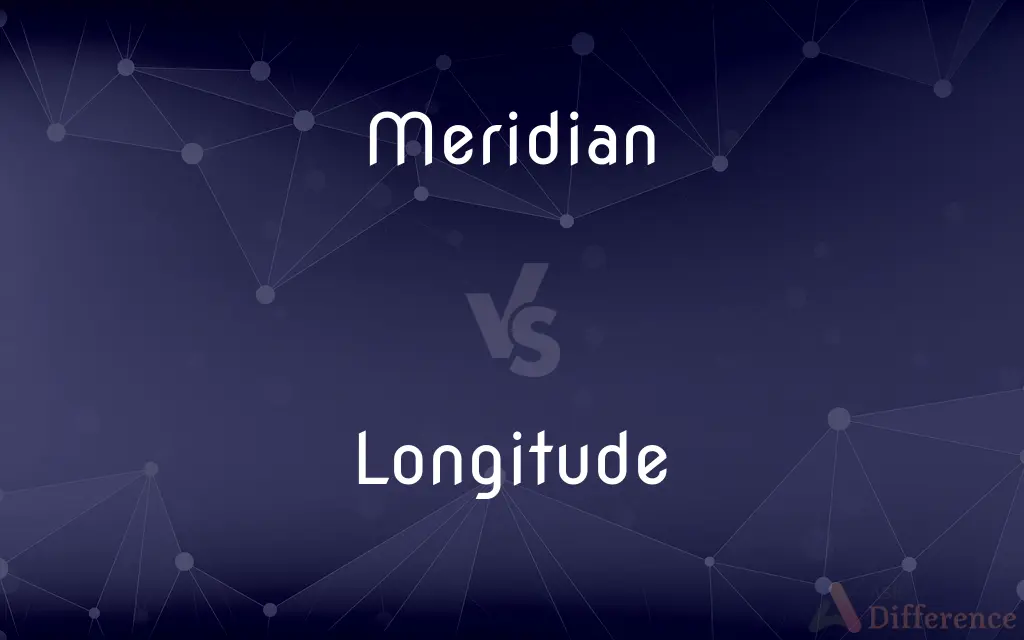Meridian vs. Longitude — What's the Difference?
By Maham Liaqat & Urooj Arif — Updated on March 13, 2024
Meridians are lines running from the North to the South Pole, while longitude measures the east or west position from the Prime Meridian.

Difference Between Meridian and Longitude
Table of Contents
ADVERTISEMENT
Key Differences
Meridian refers to any of the imaginary lines on the Earth's surface that run from the North Pole to the South Pole. These lines are used in geography and cartography to help in the precise location of places on the Earth's surface. Longitude, on the other hand, is the geographic coordinate that specifies the east or west distance of a point on the Earth's surface from the Prime Meridian. It is measured in degrees, with the Prime Meridian at 0° and the lines of longitude extending east and west from this point up to 180°.
The Prime Meridian, which passes through Greenwich, England, is the zero-degree meridian, serving as a reference point from which longitudes are measured. Longitudes are used in conjunction with latitudes, which measure north and south positions, to pinpoint locations anywhere on the Earth.
While every meridian serves as a line of longitude, not every line of longitude is referred to as a meridian in common usage. The term "meridian" often specifically refers to the Prime Meridian and the 180th meridian (the International Date Line), which are significant for timekeeping and global navigation. However, technically, each line of longitude is also a meridian, forming half of a great circle that connects the two poles.
The concept of longitude is crucial for navigation, allowing sailors and aviators to determine their east-west position on the globe. Historically, determining longitude accurately was a major challenge for navigators until the development of precise timekeeping devices. The establishment of the Prime Meridian as a universal reference point was a significant advancement in geography and navigation.
Meridians and lines of longitude are fundamental components of the Earth's geographic coordinate system, enabling the division of the Earth into time zones. Each 15-degree segment of longitude corresponds to a one-hour difference in solar time, facilitating the standardization of time across different regions of the world. This relationship between meridians, longitude, and time zones is essential for global communication, travel, and commerce.
ADVERTISEMENT
Comparison Chart
Definition
Imaginary line running from North to South Pole
Measure of east or west distance from the Prime Meridian
Reference Point
Includes the Prime Meridian and others
Based on the Prime Meridian at Greenwich, England
Measurement
Serves as a reference for longitude
Measured in degrees east or west of the Prime Meridian
Significance
Notable meridians include Prime Meridian and International Date Line
Essential for navigation and determining geographic location
Usage
Often refers to specific lines for timekeeping and navigation
Used in conjunction with latitude to pinpoint locations
Compare with Definitions
Meridian
An imaginary line on Earth's surface from the North Pole to the South Pole.
The Prime Meridian in Greenwich is the starting point for measuring longitude.
Longitude
Essential for accurate global navigation and mapping.
GPS devices use longitude and latitude to determine precise locations.
Meridian
Serves as a reference for time zones and navigation.
The Prime Meridian is used to define Greenwich Mean Time (GMT).
Longitude
Enables the calculation of time zones based on Earth's rotation.
Each degree of longitude corresponds to a four-minute difference in time.
Meridian
Significant for historical and geographical studies.
The Prime Meridian's location was determined at the International Meridian Conference in 1884.
Longitude
A geographic coordinate that specifies east or west position from the Prime Meridian.
New York City is located at approximately 74 degrees west longitude.
Meridian
Important in the division of the Earth into eastern and western hemispheres.
Countries east of the Prime Meridian are in the Eastern Hemisphere.
Longitude
Measured in degrees, minutes, and seconds.
The longitude of Sydney, Australia, is about 151 degrees east.
Meridian
Each meridian forms half of a great circle.
The 180th meridian is also known as the International Date Line.
Longitude
Facilitates international travel and commerce by providing location coordinates.
Air traffic routes are planned using longitude and latitude to navigate across the globe.
Meridian
An imaginary great circle on the earth's surface passing through the North and South geographic poles.
Longitude
Longitude (, AU and UK also ) is a geographic coordinate that specifies the east–west position of a point on the Earth's surface, or the surface of a celestial body. It is an angular measurement, usually expressed in degrees and denoted by the Greek letter lambda (λ).
Meridian
Either half of such a great circle from pole to pole. All points on the same meridian have the same longitude.
Longitude
Angular distance on the earth's surface, measured east or west from the Prime Meridian at Greenwich, England, to the meridian passing through a position, expressed in degrees (or hours), minutes, and seconds.
Meridian
(Astronomy)A great circle passing through the two poles of the celestial sphere and the zenith of a given observer.Also called celestial meridian, local meridian, vertical circle.
Longitude
Celestial longitude.
Meridian
A curve on a surface of revolution, formed by the intersection of the surface with a plane containing the axis of revolution.
Longitude
(geography) Angular distance measured west or east of the prime meridian.
Meridian
A plane section of a surface of revolution containing the axis of revolution.
Longitude
Any imaginary line perpendicular to the equator and part of a great circle passing through the North Pole and South Pole.
Meridian
Any of the longitudinal lines or pathways on the body along which the acupuncture points are distributed.
Longitude
(archaic) Length.
Meridian
The highest point in the sky reached by the sun or another celestial body; a zenith.
Longitude
Length; measure or distance along the longest line; - distinguished from breadth or thickness; as, the longitude of a room; rare now, except in a humorous sense.
The longitude of their cloaks.
Mine [shadow] spindling into longitude immense.
Meridian
The time at which the sun reaches its highest point in the sky; noon.
Longitude
The arc or portion of the equator intersected between the meridian of a given place and the meridian of some other place from which longitude is reckoned, as from Greenwich, England, or sometimes from the capital of a country, as from Washington or Paris. The longitude of a place is expressed either in degrees or in time; as, that of New York is 74° or 4 h. 56 min. west of Greenwich.
Meridian
The highest point or stage of development; peak:"Men come to their meridian at various periods of their lives"(John Henry Newman).
Longitude
The distance in degrees, reckoned from the vernal equinox, on the ecliptic, to a circle at right angles to the ecliptic passing through the heavenly body whose longitude is designated; as, the longitude of Capella is 79°.
Meridian
Midwestern US See median.
Longitude
An imaginary great circle on the surface of the earth passing through the north and south poles at right angles to the equator;
All points on the same meridian have the same longitude
Meridian
Of or relating to a meridian; meridional.
Meridian
Of or at midday:the meridian hour.
Meridian
Of, relating to, or constituting the highest point, as of development or power:the empire in its meridian period.
Meridian
Relating to a meridian (in various senses); meridional.
Meridian
Relating to midday or noon.
Meridian
(obsolete)
Meridian
Relating to the culmination or highest point.
Meridian
Relating to the south; meridional, southern.
Meridian
(astronomy)
Meridian
In full celestial meridian: a great circle passing through the poles of the celestial sphere and the zenith for a particular point on the Earth's surface.
Meridian
In full terrestrial meridian: a great circle on the Earth's surface, passing through the geographic poles (the terrestrial North Pole and South Pole); also, half of such a circle extending from pole to pole, all points of which have the same longitude.
Meridian
(by extension)
Meridian
The place on the celestial meridian where it is crossed by the sun or a star at its highest point.
Meridian
A ring or half-ring with markings in which an artificial globe is installed and may spin.
Meridian
(mathematics) A line passing through the poles of any sphere; a notional line on the surface of a curved or round body (in particular, an eyeball).
Meridian
The size of type between double great primer and canon, standardized as 44-point.
Meridian
(obsolete)
Meridian
The south.
Meridian
Midday, noon.
Meridian
A midday rest; a siesta.
Meridian
A particular area or situation considered as having a specific characteristic or identity; also, the characteristics, habits, or tastes of a specific group, locale, etc.
Meridian
(Scotland) An alcoholic drink taken at midday.
Meridian
Any of the pathways on the body along which chi or qi (life force) is thought to flow and, therefore, the acupoints are distributed; especially, one of twelve such pathways associated with organs of the body.
Meridian
(transitive) To cause an object to reach the meridian or highest point of (something).
Meridian
(intransitive) Of a celestial body: to reach its meridian.
Meridian
Being at, or pertaining to, midday; belonging to, or passing through, the highest point attained by the sun in his diurnal course.
Tables . . . to find the altitude meridian.
Meridian
Pertaining to the highest point or culmination; as, meridian splendor.
Meridian
Midday; noon.
Meridian
Hence: The highest point, as of success, prosperity, or the like; culmination.
I have touched the highest point of all my greatness,And from that full meridian of my gloryI haste now to my setting.
Meridian
A great circle of the sphere passing through the poles of the heavens and the zenith of a given place. It is crossed by the sun at midday.
Meridian
A great circle on the surface of the earth, passing through the poles and any given place; also, the half of such a circle included between the poles.
All other knowledge merely serves the concerns of this life, and is fitted to the meridian thereof.
Meridian
A town in eastern Mississippi
Meridian
An imaginary great circle on the surface of the earth passing through the north and south poles at right angles to the equator;
All points on the same meridian have the same longitude
Meridian
Of or happening at noon;
Meridian hour
Common Curiosities
What is the Prime Meridian?
The Prime Meridian is the zero-degree line of longitude from which all other longitudes are measured.
Why was determining longitude historically difficult for navigators?
Accurately determining longitude required precise timekeeping that was not achievable until the invention of chronometers.
Can meridians be used to determine time zones?
Yes, meridians are used to divide the Earth into time zones, with each 15-degree segment representing a one-hour difference in time.
What role does the Greenwich Observatory play in the concept of longitude?
The Royal Observatory in Greenwich is the location of the Prime Meridian, serving as the global reference point for longitude.
Is there a difference between how meridians and longitudes are used in mapping?
Both are used in mapping; however, "meridian" often refers to significant longitude lines like the Prime Meridian, while "longitude" is a more general term for east-west positioning.
How do meridians and longitudes facilitate global communication?
By standardizing time zones and providing precise location coordinates, they enable synchronized global communications.
How does longitude help in navigation?
Longitude, used with latitude, helps navigators and GPS systems determine precise locations on the Earth.
What is the significance of the International Date Line?
The International Date Line, located at the 180th meridian, is significant for timekeeping and marks where the date changes.
What is the difference in use between meridians and longitudes in astronomy?
In astronomy, meridians can refer to imaginary lines similar to those on Earth but projected onto celestial bodies for navigation and study.
Why was the Prime Meridian established in Greenwich, England?
Greenwich was chosen during the International Meridian Conference in 1884, due to the presence of the Royal Observatory and its significant contributions to navigation.
Can longitudes affect climate and weather patterns?
Indirectly, as they help define geographical regions which can be associated with specific climate zones.
How are meridians and longitudes related to GPS technology?
GPS technology uses a network of satellites to provide precise location information, based on longitude and latitude coordinates.
Are there any natural meridians or longitudes?
No, meridians and longitudes are human-created systems for geographical orientation and navigation.
How did sailors navigate before the precise measurement of longitude?
They relied on dead reckoning, celestial navigation, and other methods that were less accurate than longitude-based navigation.
How do longitudes relate to time calculation on Earth?
The Earth is divided into 24 time zones, each roughly corresponding to 15 degrees of longitude, reflecting the planet's rotation and the sun's position.
Share Your Discovery

Previous Comparison
Impaired vs. Incapacitated
Next Comparison
Mongols vs. HunsAuthor Spotlight
Written by
Maham LiaqatCo-written by
Urooj ArifUrooj is a skilled content writer at Ask Difference, known for her exceptional ability to simplify complex topics into engaging and informative content. With a passion for research and a flair for clear, concise writing, she consistently delivers articles that resonate with our diverse audience.















































